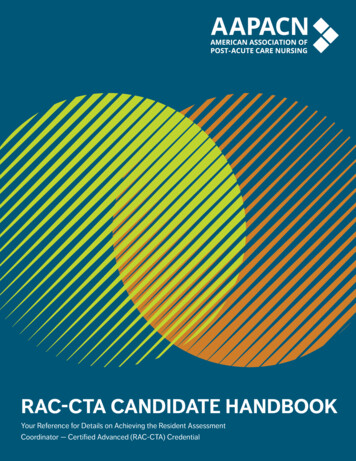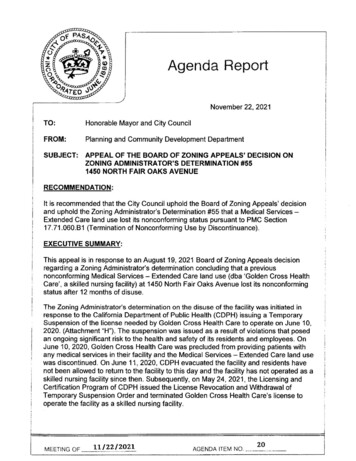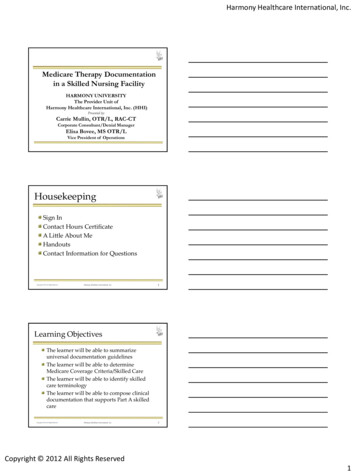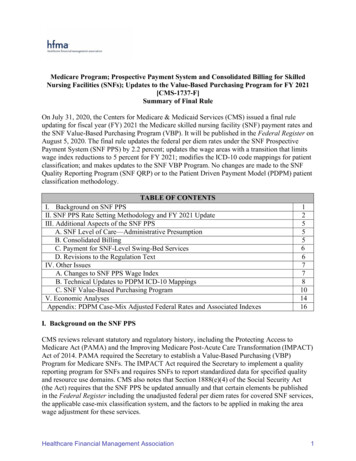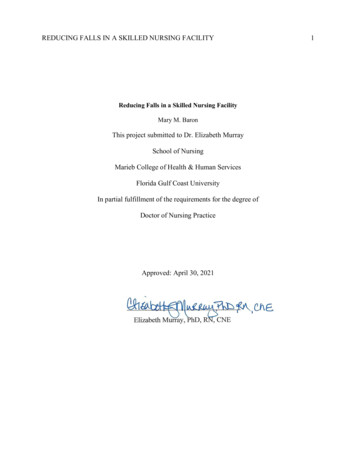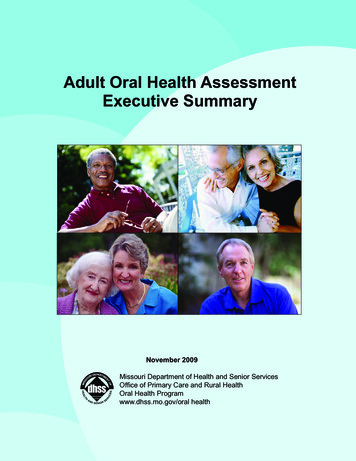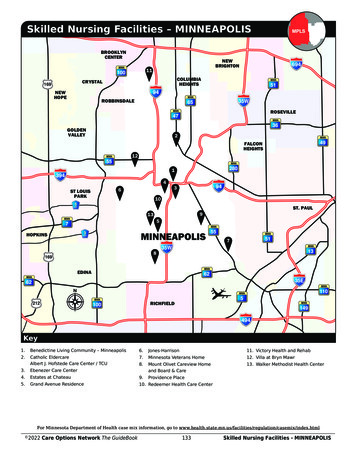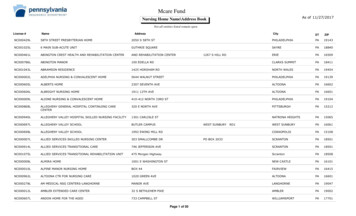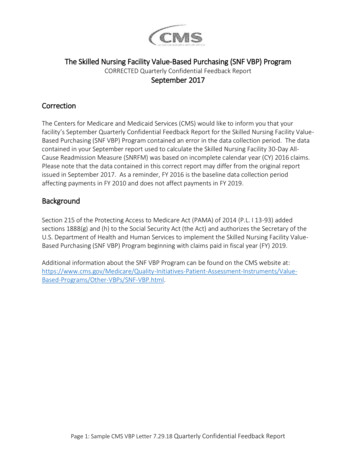
Transcription
The Skilled Nursing Facility Value-Based Purchasing (SNF VBP) ProgramCORRECTED Quarterly Confidential Feedback ReportSeptember 2017CorrectionThe Centers for Medicare and Medicaid Services (CMS) would like to inform you that yourfacility’s September Quarterly Confidential Feedback Report for the Skilled Nursing Facility ValueBased Purchasing (SNF VBP) Program contained an error in the data collection period. The datacontained in your September report used to calculate the Skilled Nursing Facility 30-Day AllCause Readmission Measure (SNRFM) was based on incomplete calendar year (CY) 2016 claims.Please note that the data contained in this correct report may differ from the original reportissued in September 2017. As a reminder, FY 2016 is the baseline data collection periodaffecting payments in FY 2010 and does not affect payments in FY 2019.BackgroundSection 215 of the Protecting Access to Medicare Act (PAMA) of 2014 (P.L. I 13-93) addedsections 1888(g) and (h) to the Social Security Act (the Act) and authorizes the Secretary of theU.S. Department of Health and Human Services to implement the Skilled Nursing Facility ValueBased Purchasing (SNF VBP) Program beginning with claims paid in fiscal year (FY) 2019.Additional information about the SNF VBP Program can be found on the CMS website ms/Other-VBPs/SNF-VBP.html.Page 1: Sample CMS VBP Letter 7.29.18 Quarterly Confidential Feedback Report
The Skilled Nursing Facility Value-Based Purchasing (SNF VBP) ProgramCORRECTED Quarterly Confidential Feedback ReportSeptember 2017Confidential Feedback ReportsSection 1888(g)(5) of the Act further requires that the Secretary begin providing quarterlyconfidential feedback reports to SNF’s regarding their performance on the measures specifiedunder the SNF VBP Program. In the table below, you will find a summary of the contents ofquarterly reports that have been disseminated to date.SNF VBP Quarterly Reports Disseminated to DateDate Disseminated toSNF’sOctober 1, 2016December 1, 2016March 1, 2017June 1, 2017September 1, 2017SNFRMMeasurementPeriodN/ACY 2013CY 2015CY 2015FY 2016Report ContentsExample ReportFacility-level dataFacility-level dataFacility-level & Staylevel dataFacility-level & Staylevel dataWill this dataaffect SNF VBPpaymentdetermination?N/ANoNoYesYesThis is your September 2017 confidential feedback report for the SNF VBP Program. Onpage 5, you will find a summary of your facility’s performance on the measure being used in theSNF VBP Program for fiscal year (FY) 2016. Please note that the information on page 5 of thisreport will be publicly reported on Nursing Home Compare or a successor website at a futuredate.In addition, we also distributed a Supplemental Workbook – a separate Excel file – that youshould have received through the CASPER reporting application. The Supplemental Workbookcontains more detailed information about SNF stays used to calculate your performance, such asidentifying information for SNF patients treated at your facility including admission/dischargedates and information on hospital readmissions, if applicable. On pages 6 through 9 of thecurrent report, you will find a User Guide to the Supplemental Workbook that providesinformation on the contents of your facility’s Supplemental Workbook.Page 2: Sample CMS VBP Letter 7.29.18 Quarterly Confidential Feedback Report
The Skilled Nursing Facility Value-Based Purchasing (SNF VBP) ProgramCORRECTED Quarterly Confidential Feedback ReportSeptember 2017Measure DescriptionThe Skilled Nursing Facility 30-Day All-Cause Readmission Measure (SNFRM) was adopted for the SNF VBPProgram in FY 2016. The SNFRM is a quality measure that assesses unplanned hospital readmission forMedicare fee-for-service (FFS) beneficiaries within 30 days of discharge from a prior proximal acute care,critical access, or psychiatric hospital stay. The SNFRM is a risk-standardized readmission rate (RSRR).The risk-adjustment approach for the SNFRM takes into account patient-level risk factors such as clinicalcharacteristics and comorbidities to ensure that providers with similar quality of care do not appeardissimilar due to differences in their respective measure is endorsed by the National Quality Forum (NQF#2510).For additional information on the SNFRM, including a full explanation as to why the risk-standardized ratediffers from the simple rate, we refer readers to our technical report1 and to our technical reportsupplement2, which contains updated analytic results for the SNFRM.SNF VBP Program ScoringSNF VBP performance scores affecting FY 2020 payment determination will be calculated using SNFRMrates from the baseline period (FY 2016) and performance period (FY 2018). Performance standards forthe baseline period (FY 2016) are reported below. For additional information on how measureperformance will impact payment under the SNF VBP Programs, we refer readers to the FY 2017 FinalRule3.SNF VBP Performance StandardsSection 1888(h)(3) of PAMA requires that the SNF VBP Program include performance standardscalculated for the baseline period – including the achievement threshold and the benchmark – againstwhich individuals SNFs’ quality measure rates in the performance period could be compared. In the FY2017 SNF PPS Final Rule, CMS defines the achievement threshold as the 25th percentile of national SNFperformance on the specified quality measure (the SNFRM) during the applicable baseline period. Thebenchmark is defined as the mean of the top decile of SNF performance on the measure during thebaseline period.In the table below, we provide the performance standards calculated for the baseline year (FY 2016)affecting payment determination in FY 2020 for the SNF VBP Program. These performance standards,along with your SNF’s RSRR for the performance period (FY 2018) will be used to calculate your SNF’sachievement and improvement scores affecting payment determination in FY 2020. The performancestandards affecting FY 2020 payment determination ere specified in the FY 2018 SNF PPS Final Rule.Page 3: Sample CMS VBP Letter 7.29.18 Quarterly Confidential Feedback Report
The Skilled Nursing Facility Value-Based Purchasing (SNF VBP) ProgramCORRECTED Quarterly Confidential Feedback ReportSeptember 2017SNF VBP Program Performance Standards: Affecting Payment Determination in FY2020MeasureAchievement ThresholdBenchmark4SNFRM0.802180.83721SOURCE: These performance standards were calculated using Medicare claims and eligibility data from FY2016 (baseline period).1Available at: ilable at le at: 16-18113.pdf4Performance standards are calculated using inverted RSRRs (1-SNFRM), meaning that a higher score isbetter. Please note the readmission rates presented on page 5 of this report have not been inverted.Page 4: Sample CMS VBP Letter 7.29.18 Quarterly Confidential Feedback Report
The Skilled Nursing Facility Value-Based Purchasing (SNF VBP) ProgramCORRECTED Quarterly Confidential Feedback ReportSeptember 2017Glossary of TermsAchievement Score – a measure of each SNF’s achievement in the performance period for theSNF VBP Program; scores range from 0 to 100; for a full explanation of how SNF achievementscores are calculated, refer to the FY 2017 SNF PPS Final Rule.Achievement Threshold – the 25th percentile of national SNF performance on the specifiedquality measure (the SNFRM) during the applicable baseline period.Baseline Period – FY 2016 is the baseline period affecting payment determination in FY 2020for the SNF VBP Program.Benchmark – the mean of the top decile of national SNF performance on the specified qualitymeasure (the SNFRM) during the applicable baseline period.Improvement Score – a measure of improvement in the SNF VBP Program from the baselineperiod to the performance period; scores range from 0 to 90; for a full explanation of how SNFimprovement scores are calculated, refer to the FY 2017 SNF PPS Final Rule.Improvement Threshold – a SNF’s performance on the specified quality measure during theapplicable baseline period.Performance Period – FY 2018 is the performance period affecting payment determination inFY 2020 for the SNF VBP Program.Performance Score – the higher of a SNF’s achievement score and improvement score for thespecified performance period. This score is used to calculate payment adjustments for the SNFVBP program.Performance Standards – comprised of the achievement threshold and the benchmark; theseare the standards against which SNF performance is compared for the purposes of calculatingSNF VBP performance scores.Page 5: Sample CMS VBP Letter 7.29.18 Quarterly Confidential Feedback Report
The Skilled Nursing Facility Value-Based Purchasing (SNF VBP) ProgramCORRECTED Quarterly Confidential Feedback ReportSeptember 2017Facility: [Facility Name]CCN: [CCN number]City, State: [City, State of Facility]Your SNF’s Performance on the Skilled Nursing Facility 30-Day All-Cause ReadmissionMeasure (SNFRM) in FY 2016MeasureYour SNF’sNumber ofEligible StaysYour SNF’sNumber ofUnplannedReadmissions*Your SNF’sRisk –StandardizedReadmissionRate **SNFRM1723019.378%Source: Medicare claims and eligibility data from fiscal year 2016.NationalAverageReadmissionRate ***18.826%* The number of stays at your SNF that were followed by an unplanned hospital readmissionwithin 30 days of discharge from a prior proximal hospitalization.** The risk-standardized readmission rate is your SNF’s risk-adjusted rate of unplannedreadmissions.*** The national average readmission rate reported here is the average unadjusted unplannedreadmission rate for all eligible SNF stays nationally.Questions?If you have questions about your data, please contact CMS at SNFVBPinquiries@cms.hhs.govPage 6: Sample CMS VBP Letter 7.29.18 Quarterly Confidential Feedback Report
The Skilled Nursing Facility Value-Based Purchasing (SNF VBP) ProgramCORRECTED Quarterly Confidential Feedback ReportSeptember 2017Supplemental Workbook User GuideThis User Guide is intended to serve as a tool to help you understand the data provided in theSNF VBP Supplemental Workbook containing your SNF’s performance on the readmissionmeasure adopted for the SNF VBP Program. This Supplemental Workbook (provided in Excel)includes measure results and underlying patient-level data. CMS is providing this more detaileddata in response to provider feedback. Please note that the information provided is notsufficient to replicate your SNF’s RSRR calculation, because this would require national data.Information on Public ReportingThe FY 2016 RSRR contained in both the September 2017 quarterly confidential feedback reportand the September 2017 Supplemental Workbook will be publicly reported on Nursing HomeCompare or a successor website at a future date.Information on Review and CorrectionsCMS is required by statute to provide SNFs with an opportunity to review and submit correctionsto measure performance data prior to its being made public. To that end, this quarterly reportwill make the start of the Review and Corrections period for the data presented in this report.The review and Corrections period for this data ends on March 31, 2018.QuestionsIf you have concerns or questions about your performance on this measure or the data youreceived, please email SNFVBPinquires@cms.hhs.gov. Note that correction requests should alsobe directed to this email address and must be received no later than March 31, 2018; please usethe subject line: SNF VBP Review and Corrections inquiry, and include your CCN.Note: The accompanying Excel file contains patient-level data that are protected by the HealthInsurance Portability and Accountability Act of 1996 (HIPAA). It is a violation of HIPAA rules toshare these protected patient-level data with other organizations, including the press. Emailingprotected health information poses a security issue, and each HIPAA- covered entity isresponsible for ensuring compliance with the security standards.Page 7: Sample CMS VBP Letter 7.29.18 Quarterly Confidential Feedback Report
The Skilled Nursing Facility Value-Based Purchasing (SNF VBP) ProgramCORRECTED Quarterly Confidential Feedback ReportSeptember 2017SNF VBP SUPPEMENTAL WORKBOOKFILE CONTENTS AND DESCRIPTIONSYour facility’s Supplemental Workbook contains your FY 2016 SNFRM measure results andunderlying patient-level data. This information is presented in three tabs or worksheets,including:Tab 1 – Cover SheetTab 2 – Facility ResultsTab 3 – Eligible StaysBelow you will find a detailed description of the contents of each worksheet in your facility’sSupplemental Workbook. For additional information regarding SNFRM calculation, we referreaders to the SNFRM Technical Report, available Tab 1. Cover SheetThe first tab in the Supplemental Workbook provides the measure title, data collection period,provider name. CMS Certification Number (CNN), and a brief description of the report’scontents.Tab 2. Facility ResultsThe second tab is the Supplemental Workbook (Facility Results) includes the followinginformation calculated using index SNF stays with admission dates from October 1, 2015,through September 30, 2016.ROW NAMEYour SNF’s Number of EligibleStaysYour SNF’s Number ofUnplanned ReadmissionsYour SNF’s ObservedReadmission RateDESCRIPTIONThe total number of SNF stays that met the inclusioncriteria and were used to calculate your SNF’sperformance during this reporting period.The total number of eligible SNF stays with anunplanned readmission during the 30-day readmissionwindow.Your SNF’s unadjusted rate of unplanned readmissions.This is calculated by dividing your SNF’s total number ofPage 8: Sample CMS VBP Letter 7.29.18 Quarterly Confidential Feedback Report
The Skilled Nursing Facility Value-Based Purchasing (SNF VBP) ProgramCORRECTED Quarterly Confidential Feedback ReportSeptember 2017Your SNF’s Predicted Numberof ReadmissionsYour SNF’s Expected Numberof Readmissionsunplanned readmissions by your SNF’s total number ofeligible stays, and then multiplying by 100.The number of unplanned readmission predicted basedon your SNF’s performance given your SNF’s case mix.5The number of readmissions that would be expected ifthe patients at your SNF were treated at the averageSNF. 5An indicator of your SNF’s effect on readmission rates.Your SNF’s Standardized RiskIt is calculated by dividing the predicted number ofRatio (SRR)readmissions at your facility by the expected number ofreadmissions for the same patients if these patients hadbeen treated at the average SNF. This is a ration wherevalues greater than 1.0 suggest a higher/worse thanexpected readmission rate and values less than 1.0suggest a lower/better than expected readmission rate.National Average Readmission The unadjusted readmission rate for all eligible SNFstays nationally. It is calculated by dividing the totalRatenumber of unplanned readmission for all SNF’s by thetotal number of eligible stays for all SNFs, and thenmultiplying by 100.Your SNF’s risk adjusted rate of unplannedYour SNF’s Risk-Standardizedreadmissions. It accounts for patient-level risk factorsReadmission Rate (RSRR)such as clinical characteristics and comorbidities. It iscalculated by multiplying your SNF’s standardized riskration by the overall national raw readmission rate forall SNF stays.5Correction: The values for Predicted and Expected Numbers of Readmissions in your previousSeptember Supplemental Workbook were expressed as percentages rather than numbers. Thecorrected Supplemental Workbook contains your facility’s Predicted and Expected Numbers ofReadmissionThe information provided in the Facility Results tab of your Supplemental Workbook is, in part,intended to help you trace the calculation of your SNF’s observed and risk-standardizedreadmission rates.6 Your SNF’s observed readmission rate is calculated by dividing your SNF’stotal number of unplanned readmission by your SNF’s total number of eligible stays.Page 9: Sample CMS VBP Letter 7.29.18 Quarterly Confidential Feedback Report
The Skilled Nursing Facility Value-Based Purchasing (SNF VBP) ProgramCORRECTED Quarterly Confidential Feedback ReportSeptember 2017Your SNF’s Number of Unplanned Readmissions Your SNF’s Observed Readmission RateYour SNF’s Number of Eligible StaysTo calculate your SNF’s risk-standardized readmission rate (RSRR), you must first divide yourSNF’s predicted number of readmissions by your SNF’s expected number of readmissions to getyour standardized risk ration (SRR). The product of your SNF’s SSR and the national averagereadmission rate is your SNF’s RSRR.1. Your SNF’s Predicted Number of Readmissions Your SNF’s Standardized Risk Ratio (SRR)Your SNF’s Expected Number of Readmissions2. Your SNF’s SRR X National Average Readmission Rate Your SNF’s RSRRPage 10: Sample CMS VBP Letter 7.29.18 Quarterly Confidential Feedback Report
The Skilled Nursing Facility Value-Based Purchasing (SNF VBP) ProgramCORRECTED Quarterly Confidential Feedback ReportSeptember 2017Tab 3. Eligible StaysThe third tab in the Supplemental Workbook (Eligible Stays) includes the following informationfor patients with index SNF stays who had admission dates from October 1, 2015, throughSeptember 30, 2016.COLUMNColumn BVARIABLE NAMEID NumberColumn CHICNColumn DColumn EColumn FSexAgeAdmission Date ofIndexSNF StayDischarge date for index SNF stay (DDMONYYYY).Discharge Date ofIndexSNF StayIndex SNF Discharge Destination to which the patient was discharged. See theResDAC site for information regarding the coding of thisStatus CodeColumn GColumn HColumn IColumn JPrior ProximalHospitalCCNAdmission Date ofPriorProxima HospitalStayDESCRIPTIONUnique identifier for each patient’s SNF stay included inthe worksheet. This is an arbitrary number generatedstrictly for the purposes of identifying SNF stays in theworksheet.6- to 12- digit beneficiary Medicare health insurance claim(HIC) account number. Note: This is not the same as theSocial Security Number.The sex of the beneficiary.The age of the beneficiary at the time of SNF admission.Admission date for index SNF stay (DDMONYYYY)variable: schage-status-code.CMS Certification Number (CCN) of the prior proximalhospital from which the SNF patient was discharged.Admission date for prior proximal hospital stay(DDMONYYY)Page 11: Sample CMS VBP Letter 7.29.18 Quarterly Confidential Feedback Report
The Skilled Nursing Facility Value-Based Purchasing (SNF VBP) ProgramCORRECTED Quarterly Confidential Feedback ReportSeptember 2017Discharge Date ofPriorProximal HospitalStayICD Version ofPrincipalDiagnosis (PriorProximal Hospital)Principal Diagnosisof Prior ProximalHospital StayPlannedReadmissionDischarge date for prior proximal hospital stay(DDMONYYY)Column OUnplannedReadmissionColumn PReadmissionHospital CCNColumn QReadmissionAdmission DateColumn RReadmissionDischarge DateColumn SICD Version ofPrincipal DiagnosisIndicates whether a SNF patient was readmitted for anunplanned procedure within the 30-day readmissionwindow. 1: SNF patient was readmitted for an unplannedprocedure. 0: SNF patient was not readmitted for anunplanned procedure.If there was a readmission, this refers to the CCN of thehospital to which the SNF patient was readmitted. If theSNF patient did not have a readmission within the 30-dayreadmission window, the cell will be left blank.Admission date for hospital readmission (DDMONYYYY). Ifthe SNF patient did not have a readmission within the 30day readmission window, the cell will be left blank.Discharge date for hospital readmission (DDMONYYY). Ifthe SNF patient did not have a readmission within the 30day readmission window, the cell will be left blank.Indicates if the principal diagnosis on the readmissionclaim reflects ICD-9 or ICD-10 coding conventions. (:Column KColumn LColumn MColumn NIndicates if the principal diagnosis on the prior proximalclaim reflects ICD-9 or ICD-10 coding conventions. 9:Principal diagnosis reflects ICD-9 coding conventions. 10:Principal diagnosis reflects ICD-10 coding conventions.Principal Diagnosis code of the prior proximal hospitalstay.Indicates whether a SNF patient was readmitted for aplanned procedure within the 30-day readmissionwindow. 1: SNF patient was readmitted for a plannedprocedure. 0: SNF patient was not readmitted for aplanned procedure.Page 12: Sample CMS VBP Letter 7.29.18 Quarterly Confidential Feedback Report
The Skilled Nursing Facility Value-Based Purchasing (SNF VBP) ProgramCORRECTED Quarterly Confidential Feedback ReportSeptember 2017Column TColumn UKM(ReadmissionHospital)Principal Diagnosisof ReadmissionHospitalRisk AdjustersPrincipal diagnosis reflects ICD-9 coding conventions. 10:Principal diagnosis reflects ICD-10 coding conventions.Principal diagnosis code of the readmission stay. If theSNF patient did not have a readmission within the 30-dayreadmission window, the cell will be left blank.These columns contain risk adjusters used in the model tocalculate the measure. Values are “1” if the beneficiarywas identified as having that risk adjuster; “0” otherwise.This risk adjusters include the following; original reasonfor Medicare entitlement, if currently aged; end-stagerenal disease; count of acute stays prior to most recent;length of prior proximal stay; surgical patient indicator, ifany; principal diagnosis form prior proximal stay (usingClinical Classifications Software (CCS) groupings); indicatorof any days in an intensive care unit (ICU) during priorproximal stay; comorbidities (using Hierarchical ConditionCategory (HCC) groupings); and an indicator of a count ofmultiple comorbidities. Risk adjusters that are used asreference groups when a patient must be in one of a setof categories are denoted by a ‘REF’ in the variable label.We Refer users to the SNFRM Technical Report for moredetail on risk-adjustment and measure calculation.NOTE: This worksheet contains personally indefinable information (PII) and protected healthinformation (PHI). Do NOT email the contents of you patient-level worksheet.Page 13: Sample CMS VBP Letter 7.29.18 Quarterly Confidential Feedback Report
improvement scores are calculated, refer to the FY 2017 SNF PPS Final Rule. Improvement Threshold -a SNF's performance on the specified quality measure during the applicable baseline period. Performance Period - FY 2018 is the performance period affecting payment determination in FY 2020 for the SNF VBP Program.


